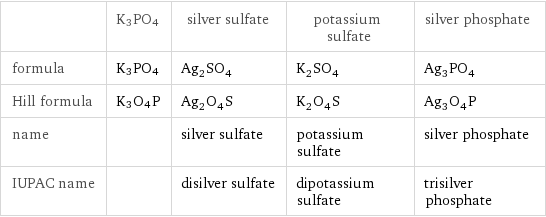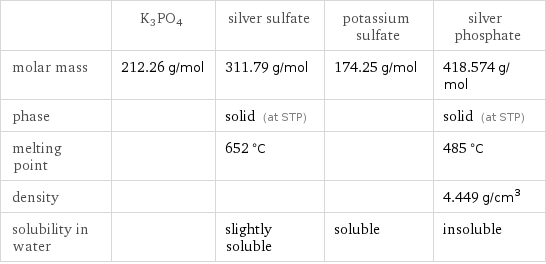Input interpretation

K3PO4 + Ag_2SO_4 silver sulfate ⟶ K_2SO_4 potassium sulfate + Ag_3PO_4 silver phosphate
Balanced equation

Balance the chemical equation algebraically: K3PO4 + Ag_2SO_4 ⟶ K_2SO_4 + Ag_3PO_4 Add stoichiometric coefficients, c_i, to the reactants and products: c_1 K3PO4 + c_2 Ag_2SO_4 ⟶ c_3 K_2SO_4 + c_4 Ag_3PO_4 Set the number of atoms in the reactants equal to the number of atoms in the products for K, P, O, Ag and S: K: | 3 c_1 = 2 c_3 P: | c_1 = c_4 O: | 4 c_1 + 4 c_2 = 4 c_3 + 4 c_4 Ag: | 2 c_2 = 3 c_4 S: | c_2 = c_3 Since the coefficients are relative quantities and underdetermined, choose a coefficient to set arbitrarily. To keep the coefficients small, the arbitrary value is ordinarily one. For instance, set c_1 = 1 and solve the system of equations for the remaining coefficients: c_1 = 1 c_2 = 3/2 c_3 = 3/2 c_4 = 1 Multiply by the least common denominator, 2, to eliminate fractional coefficients: c_1 = 2 c_2 = 3 c_3 = 3 c_4 = 2 Substitute the coefficients into the chemical reaction to obtain the balanced equation: Answer: | | 2 K3PO4 + 3 Ag_2SO_4 ⟶ 3 K_2SO_4 + 2 Ag_3PO_4
Structures

K3PO4 + ⟶ +
Names

K3PO4 + silver sulfate ⟶ potassium sulfate + silver phosphate
Equilibrium constant
![Construct the equilibrium constant, K, expression for: K3PO4 + Ag_2SO_4 ⟶ K_2SO_4 + Ag_3PO_4 Plan: • Balance the chemical equation. • Determine the stoichiometric numbers. • Assemble the activity expression for each chemical species. • Use the activity expressions to build the equilibrium constant expression. Write the balanced chemical equation: 2 K3PO4 + 3 Ag_2SO_4 ⟶ 3 K_2SO_4 + 2 Ag_3PO_4 Assign stoichiometric numbers, ν_i, using the stoichiometric coefficients, c_i, from the balanced chemical equation in the following manner: ν_i = -c_i for reactants and ν_i = c_i for products: chemical species | c_i | ν_i K3PO4 | 2 | -2 Ag_2SO_4 | 3 | -3 K_2SO_4 | 3 | 3 Ag_3PO_4 | 2 | 2 Assemble the activity expressions accounting for the state of matter and ν_i: chemical species | c_i | ν_i | activity expression K3PO4 | 2 | -2 | ([K3PO4])^(-2) Ag_2SO_4 | 3 | -3 | ([Ag2SO4])^(-3) K_2SO_4 | 3 | 3 | ([K2SO4])^3 Ag_3PO_4 | 2 | 2 | ([Ag3PO4])^2 The equilibrium constant symbol in the concentration basis is: K_c Mulitply the activity expressions to arrive at the K_c expression: Answer: | | K_c = ([K3PO4])^(-2) ([Ag2SO4])^(-3) ([K2SO4])^3 ([Ag3PO4])^2 = (([K2SO4])^3 ([Ag3PO4])^2)/(([K3PO4])^2 ([Ag2SO4])^3)](../image_source/a79afb5cafceaf760a259a75a53b58c4.png)
Construct the equilibrium constant, K, expression for: K3PO4 + Ag_2SO_4 ⟶ K_2SO_4 + Ag_3PO_4 Plan: • Balance the chemical equation. • Determine the stoichiometric numbers. • Assemble the activity expression for each chemical species. • Use the activity expressions to build the equilibrium constant expression. Write the balanced chemical equation: 2 K3PO4 + 3 Ag_2SO_4 ⟶ 3 K_2SO_4 + 2 Ag_3PO_4 Assign stoichiometric numbers, ν_i, using the stoichiometric coefficients, c_i, from the balanced chemical equation in the following manner: ν_i = -c_i for reactants and ν_i = c_i for products: chemical species | c_i | ν_i K3PO4 | 2 | -2 Ag_2SO_4 | 3 | -3 K_2SO_4 | 3 | 3 Ag_3PO_4 | 2 | 2 Assemble the activity expressions accounting for the state of matter and ν_i: chemical species | c_i | ν_i | activity expression K3PO4 | 2 | -2 | ([K3PO4])^(-2) Ag_2SO_4 | 3 | -3 | ([Ag2SO4])^(-3) K_2SO_4 | 3 | 3 | ([K2SO4])^3 Ag_3PO_4 | 2 | 2 | ([Ag3PO4])^2 The equilibrium constant symbol in the concentration basis is: K_c Mulitply the activity expressions to arrive at the K_c expression: Answer: | | K_c = ([K3PO4])^(-2) ([Ag2SO4])^(-3) ([K2SO4])^3 ([Ag3PO4])^2 = (([K2SO4])^3 ([Ag3PO4])^2)/(([K3PO4])^2 ([Ag2SO4])^3)
Rate of reaction
![Construct the rate of reaction expression for: K3PO4 + Ag_2SO_4 ⟶ K_2SO_4 + Ag_3PO_4 Plan: • Balance the chemical equation. • Determine the stoichiometric numbers. • Assemble the rate term for each chemical species. • Write the rate of reaction expression. Write the balanced chemical equation: 2 K3PO4 + 3 Ag_2SO_4 ⟶ 3 K_2SO_4 + 2 Ag_3PO_4 Assign stoichiometric numbers, ν_i, using the stoichiometric coefficients, c_i, from the balanced chemical equation in the following manner: ν_i = -c_i for reactants and ν_i = c_i for products: chemical species | c_i | ν_i K3PO4 | 2 | -2 Ag_2SO_4 | 3 | -3 K_2SO_4 | 3 | 3 Ag_3PO_4 | 2 | 2 The rate term for each chemical species, B_i, is 1/ν_i(Δ[B_i])/(Δt) where [B_i] is the amount concentration and t is time: chemical species | c_i | ν_i | rate term K3PO4 | 2 | -2 | -1/2 (Δ[K3PO4])/(Δt) Ag_2SO_4 | 3 | -3 | -1/3 (Δ[Ag2SO4])/(Δt) K_2SO_4 | 3 | 3 | 1/3 (Δ[K2SO4])/(Δt) Ag_3PO_4 | 2 | 2 | 1/2 (Δ[Ag3PO4])/(Δt) (for infinitesimal rate of change, replace Δ with d) Set the rate terms equal to each other to arrive at the rate expression: Answer: | | rate = -1/2 (Δ[K3PO4])/(Δt) = -1/3 (Δ[Ag2SO4])/(Δt) = 1/3 (Δ[K2SO4])/(Δt) = 1/2 (Δ[Ag3PO4])/(Δt) (assuming constant volume and no accumulation of intermediates or side products)](../image_source/73c7f96c2bd91a7460f96b34370d58ac.png)
Construct the rate of reaction expression for: K3PO4 + Ag_2SO_4 ⟶ K_2SO_4 + Ag_3PO_4 Plan: • Balance the chemical equation. • Determine the stoichiometric numbers. • Assemble the rate term for each chemical species. • Write the rate of reaction expression. Write the balanced chemical equation: 2 K3PO4 + 3 Ag_2SO_4 ⟶ 3 K_2SO_4 + 2 Ag_3PO_4 Assign stoichiometric numbers, ν_i, using the stoichiometric coefficients, c_i, from the balanced chemical equation in the following manner: ν_i = -c_i for reactants and ν_i = c_i for products: chemical species | c_i | ν_i K3PO4 | 2 | -2 Ag_2SO_4 | 3 | -3 K_2SO_4 | 3 | 3 Ag_3PO_4 | 2 | 2 The rate term for each chemical species, B_i, is 1/ν_i(Δ[B_i])/(Δt) where [B_i] is the amount concentration and t is time: chemical species | c_i | ν_i | rate term K3PO4 | 2 | -2 | -1/2 (Δ[K3PO4])/(Δt) Ag_2SO_4 | 3 | -3 | -1/3 (Δ[Ag2SO4])/(Δt) K_2SO_4 | 3 | 3 | 1/3 (Δ[K2SO4])/(Δt) Ag_3PO_4 | 2 | 2 | 1/2 (Δ[Ag3PO4])/(Δt) (for infinitesimal rate of change, replace Δ with d) Set the rate terms equal to each other to arrive at the rate expression: Answer: | | rate = -1/2 (Δ[K3PO4])/(Δt) = -1/3 (Δ[Ag2SO4])/(Δt) = 1/3 (Δ[K2SO4])/(Δt) = 1/2 (Δ[Ag3PO4])/(Δt) (assuming constant volume and no accumulation of intermediates or side products)
Chemical names and formulas

| K3PO4 | silver sulfate | potassium sulfate | silver phosphate formula | K3PO4 | Ag_2SO_4 | K_2SO_4 | Ag_3PO_4 Hill formula | K3O4P | Ag_2O_4S | K_2O_4S | Ag_3O_4P name | | silver sulfate | potassium sulfate | silver phosphate IUPAC name | | disilver sulfate | dipotassium sulfate | trisilver phosphate
Substance properties

| K3PO4 | silver sulfate | potassium sulfate | silver phosphate molar mass | 212.26 g/mol | 311.79 g/mol | 174.25 g/mol | 418.574 g/mol phase | | solid (at STP) | | solid (at STP) melting point | | 652 °C | | 485 °C density | | | | 4.449 g/cm^3 solubility in water | | slightly soluble | soluble | insoluble
Units
